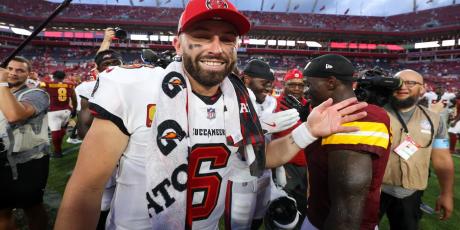MFL10 Optimal Roster Construction

There are multiple strategies in MFL10s and I will break down how to approach each position. Any data that is referenced in this article will be from early March Average Draft Position. This article is designed to be a general strategy overview of how to draft each position in 2016. Player values will change throughout the drafting season but these principles can still be applied. In a future article, we will dive deep into how to handle rookies.
Editor's Note: Early Bird Rates for our 2016 NFL DFS Subscription are available NOW! Sign up HERE.
Quarterbacks
Late round quarterback strategy seems to have finally caught up to MFL10s. In both 2014 and 2015 there were two quarterbacks taken in the first three rounds, and four through the first six rounds. In 2016, so far, we are seeing the first quarterback (Cam Newton) go in the fifth round. With the abundance of top-quality and serviceable quarterbacks, waiting on quarterbacks has never been more beneficial.
This year there are two different strategies I am deploying:
- One stud – If I can grab Newton, Andrew Luck, or Aaron Rodgers at a round or two below their current ADP, and other positional options are gone, I will take the quarterback. I would also be fine with Ben Roethlisberger, Russell Wilson, or Tom Brady as my stud if they fell far enough.
- No stud – If I can’t get a value on a top quarterback, there are many serviceable quarterbacks in round 13 and later. Any combination of Andy Dalton, Eli Manning, Tony Romo, Kirk Cousins, Tyrod Taylor, or others, are good enough to have. If I don’t fully trust the health or performance of the two I have, I may grab a third really late.
| Player | 2014 ADP | 2015 ADP | 2016 ADP | 2015-16 Difference |
|---|---|---|---|---|
| Andrew Luck | 64 | 22 | 64 | -42 |
| Drew Brees | 46 | 82 | 107 | -25 |
| Russell Wilson | 120 | 61 | 78 | -17 |
| Ben Roethlisberger | 136 | 75 | 88 | -13 |
The table above shows how some of the top quarterbacks are slipping compared to years past, which makes waiting on a quarterback (even a top one) a viable strategy.
Running Backs
Running backs are still extremely valuable in 2016 MFL10s, even after the disastrous running back production of 2015. Looking back to 2014, where running backs produced closer to expectation, a running back heavy approach proved to be a profitable strategy.
Running backs are important to stock up on in MFL10s as you have to start two each week (or three with the flex). Getting serviceable running backs is necessary no matter where you draft them. Between injuries, bye weeks, and the chance of poor production, the lack of a waiver wire makes rostering five to six running backs a virtual necessity.
Strategies on how to approach running backs:
- Studs early and often – With this strategy, you select three to four running backs through the first five rounds. By implementing this strategy, you can stop at five total running backs, freeing up roster spots for other positions. Running backs have a relatively high chance of getting injured or under-performing (as 2015 demonstrated), but taking on some extra risk by investing heavily in one position may be necessary in a league where you are shooting for first place.
- Just a few studs – This is my prefered strategy; a mix of a few top running backs with wide receivers through the first five-six rounds. Generally, I shoot for two to three running backs through the first five rounds. This gives you flexibility to grab the best player available as they drop, especially if you have a pick in the middle of the round. Mixing in upside with point per reception (PPR) backs later on can help bolster that running back corps.
- Late RB approach – A true “Go big or go home” approach to MFL10 drafts. With this strategy you load up on wide receivers and possibly a top tight end like Rob Gronkowski through the early rounds, maybe taking just one running back through the first five rounds. The key to this approach is getting upside running backs like Jonathan Stewart (late fifth), Giovani Bernard (early sixth), Danny Woodhead (late sixth), or Charles Sims (early seventh). Pairing these value running backs with late fliers like Lance Dunbar (14th) or Zach Zenner (14th) can help hold down the fort in the back field. The key to this strategy isn’t counting on getting lucky with a Devonta Freeman type season, but having wide receivers that are so good that you usually just need serviceable weeks from your running backs
Wide Receivers
Wide Receivers are the lifeblood of any winning MFL10 team. Having to start three each week (along with the possible flex spot), combined with the PPR scoring, make wide receivers very valuable. In each draft you will want to end up with somewhere between six and eight receivers.
Wide Receiver strategies:
- Early – Drafting four to five wide receivers in the first five rounds is very tempting and can lead to a very strong team. This strategy may allow you to roster only six or seven receivers, freeing up space for more running backs. There are very solid receiver options through the first five rounds, so the opportunity to go wide receiver heavy is a fine option.
- Late – Going running back heavy leads to needing to load up on wide receivers in the middle rounds. There are plenty of decent options through the middle rounds, but they carry some risk. Players like Stefon Diggs (7th), Breshad Perriman (8th), Willie Snead (8th), or Tavon Austin (9th) can help, especially since the MFL10 best ball format favors these high upside type players.
- Stacking – There are two ways to utilize this strategy. One is stacking a cheap wide receiver with the same team’s stud, such a pairing Markus Wheaton with Antonio Brown or Stevie Johnson with Keenan Allen. The other way is grabbing two cheap receivers on the same team such as Terrance Williams and Cole Beasley, or some combination of Green Bay receivers (Jeff Janis, Devante Adams, Ty Montgomery). Understanding that MFL10s are best ball, and not having to guess which receiver on a given team will have a big week makes stacking a viable strategy.
Tight Ends
Having Rob Gronkowski in his own tier has never been more in play. Last year Jimmy Graham was going in the third round, but this year the closest tight ends to Gronk are Jordan Reed, Tyler Eifert, and Greg Olsen, all currently going in the fifth round.
This year there are four tiers:
- Rob Gronkowski Tier – Take him in the later part of the first round (pick eight or later) if you want to lock down the tight end position. I am only doing this sparingly. Though Gronk is amazing, there is added risk in this format when investing so heavily in a position where you only start one player. If I do select Gronk in the first, I am only taking one other tight end and that pick will be in the 14th round or later.
- TE1 Tier - Reed, Eifert, Olsen, Travis Kelce, Delanie Walker, and Zach Ertz, in that order, is my next tier of tight ends. These guys are also great to have on a roster, and if I can get one of them at a good value, then I jump on them. If I can pair another decent TE with this group, then two tight ends may be enough.
- Low end TE1/High end TE2 Tier – This tier combines risk with upside, and includes the likes of Gary Barnidge, Julius Thomas, Austin Seferian-Jenkins, Eric Ebron, Martellus Bennett, and Jimmy Graham. It is a group of tight ends that could put up TE1 numbers, but could also greatly disappoint. These guys are great for pairing with a top-tier option. They are too expensive to be paired with Gronk, and if they are your first tight end selected, they should be part of a trio on your roster.
- Flyer level tight ends – This tier of players is reserved for pairing with Gronk, the second tier, or adding as your third tight end. This group consists of Coby Fleener, Ben Watson, Richard Rodgers, Kyle Rudolph, and others in rounds 15 or later.
Defense/Special Teams
Defense (which includes special teams) is typically very boring, as it is in any league. It should be noted that Denver is being drafted around the 12th-13th round, which is really early for a D/ST. Last year four teams were drafted in rounds 11-13: Seattle (finished 5th), Buffalo (19th), Houston (16th), and St. Louis (6th). While Seattle and St. Louis did perform well, Buffalo and Houston did not.
Taking a D/ST early can be risky as Buffalo and Houston demonstrated. If you are doing many MFL10s, it’s a great idea to mix up your D/ST selections across your drafts. This will help you avoid under-performing, expensive D/ST and will give you some shares of those cheap D/ST that out-perform their ADP like the Steelers and Vikings last year. At the end of the draft if there are no players in other positions of need that you like, taking a third D/ST can net you more points than a low upside risky pick.


















